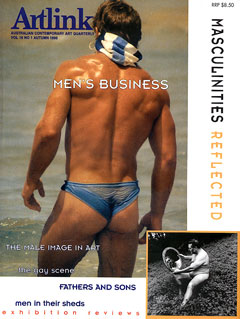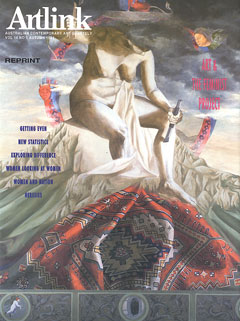The image used on the poster for Alexis Hunter's show Radical Feminism in the 1970s seems almost a parody of aggressive masculinity.
By Adam Gifford

It's a side-on shot of a male torso, naked from the waist up, leather trousered below, hand on hip holding a cigarette, New York's twin towers in ghostly shadow behind.
Treating the male as a sexual object was unusual in the early 1970s when the photo was taken.
"There is always a journey to making a piece of work," says Hunter, now back in her home in Camden, London, after spending the summer in New Zealand.
The photos were source material for a photo-realist painting now owned by the Auckland City Art Gallery, and on loan to a survey of feminist art touring North America. Her original impetus was a study of European tattoos embarked on when she arrived in London in 1972, after studying painting at Elam.
"I heard a lecture at the Royal Academy which described tattooing in a very denigrating way - that it was primitive. I was angry because I know from New Zealand culture that tattooing was a very important part of Maori social structure.
"After the lecture I decided to go out on to the street and take photos of people with tattoos, and ask why they had them. That was the project. Sometimes you do something because you are interested, and the art comes later."
When she showed the tattoo photos, she was challenged for taking sexist photos of men.
"That's because when you take a close shot of an arm by the side, you take in the pelvis. I thought, how can you take a sexist picture of a man if men have that power in society? Sexism comes from being in a position to look at a person and make them into an object. Art history does that to women."
Hunter looked further at the new feminist ideas about what words like sexism mean.
"It was just at the beginning of talking about those things. A lot of us were working in the dark. People think you get art from ideas but the fact is the art is the idea. Sometimes the painting is the theory. The way people look at it completes the theory."
Interest in early feminist art has prompted requests for Hunter to dig into her archives.
"There was a lot of interest a couple of years ago in early conceptual art, so the feminist art came just after that and is seen as part of that movement," she says.
"In the 1970s we felt empowered to change society, and thought we could do so by making art. People now don't feel that, and they want to learn how we did it."
Part of how Hunter did it was remembering the lessons of her tutor and mentor at Elam, painter Colin McCahon.
"Though my work does not look like his, I think it follows his ethics in the sense that you have to see yourself as a social being in society and that you have responsibilities as an artist."
She says the Art of the Feminist Revolution show, which opened in Los Angeles last month, "has people so excited because the work is so raw, so hard, so to the point. Some of the stuff cannot be surpassed in the way of bravery or breaking taboos".
Artists like Hunter used themselves as raw material to explore how the culture controlled how women could look and behave. "We were ridiculed in the press. We couldn't get work."
She says friends coming to the end of tenured careers in art schools have offered her sorts of apologies for not getting her jobs. "They said, 'We couldn't, you were a feminist artist'."
She also encountered problems getting her images printed, including one of a woman cutting her nails with a razor blade and another of a woman burning a pair of silver high heel shoes.
"A few were out of focus because I was using focus to suggest intellectual awakening. When I took them to the printer, they would refuse to do them because they suspected they were feminist work. They would claim they could not print out of focus work. I would have to take the manager out for a drink and get them done at night."
The Whitespace show is a small selection from a large survey last year at the Norwich Gallery in England.
What: Radical Feminism in the 1970s, by Alexis Hunter
Where and when: Whitespace Gallery, 12 Crummer Rd, to April 14
http://www.nzherald.co.nz/topic/story.cfm?c_id=544&objectid=10432382







 Video
Video MP3 Download
MP3 Download


















